Table of contents
The onion ( Allium cepa ), also known as cooking onion or kitchen onion, is one of the oldest cultivated plants and is considered a medicinal plant. Onions are used raw and cooked and are also available organically .
Use in the kitchen
The onion bulb or onion leek can be finely chopped, cut into rings, and enjoyed raw, dried , steamed or roasted. Alternatively, onion powder is easy to measure out and is popular for seasoning yoghurt dips, salad dressings and aperitif pastries.
The sulphide-containing essential oil of the onion has an irritating effect on the stomach and weakens when heated. This happens because heating releases the sugar from the glycosidic compounds. This is how the sweet taste of cooked or fried onions comes about. Red onions and vegetable onions are milder in taste than yellow or white onions. The latter is a very large, mild to sweet tasting variety of onion.
Onions taste great raw in or as a salad, in spreads on bread or in dips or sauces with raw vegetable sticks. The young ones (sometimes mistakenly called spring onions or winter onions) are ideal for garnishing dishes. Shallots are also well suited to raw food cooking, as they have a sweet, less spicy taste than kitchen onions.
Cooked onions enhance almost any dish. They go well (depending on their color) in clear or thick soups, sauces, stews and casseroles. They also taste good with fried or steamed vegetables. Vegan stuffed onions are a real eye-catcher and quick to prepare. Onion rings (raw or fried) add both visual and flavor to pizza, tarte flambée, quiche, pasta, salads and rice dishes. Vegan cheese spaetzle or Älplermagronen are hard to imagine without onions. Vegan onion cake is a piquant-tasting dish with, for example, smoked tofu .
When marinated in apple cider vinegar and herbs, the color and flavor of onions (pickles) change. Pickled small pearl onions, a variety without skin, are commercially available. Onion chutney is also popular.
To reduce the slightly unpleasant smell of breath after eating raw onions, you can try the following: Chewing fresh green herbs such as mint , parsley or basil neutralizes the smell of onions with the chlorophyll they contain. You can also try lemon juice or water, apple cider vinegar (1 teaspoon in a glass of water) or green tea. A few cardamom seeds , chewed or brewed as a tea, can break down the sulfur compounds in a similar way to a freshapple and thus reduce the smell.
When cutting (light) onions, pink discoloration can occur, similar to garlic , which turns greenish. This discoloration is caused by reactions between amino acids and sulfur compounds. 19
Recipe for vegan onion and orange salad
Ingredients (for 2 people): 2 onions, 2 oranges , 3 tablespoons vinegar (can be omitted), 3 tablespoons oil (e.g. cold-pressed linseed oil ), 1 pinchof pepper , 1 pinch of salt , 1 sprig of fresh rosemary .
Preparation: Peel the oranges and cut them crosswise into thin slices with a sharp knife. Collect the juice. Cut the onions into thin rings and mix them with the orange slices in a bowl. Wash the rosemary and chop finely. Mix the orange juice, oil, vinegar, salt, pepper and rosemary well, pour over the salad and serve.
Vegan recipes with onions (raw) can be found under the note: " Recipes that have the most of this ingredient ".
| Not only vegans or vegetarians should read this: Vegans often eat unhealthily. Avoidable nutritional mistakes . |
Purchasing - Storage
Major retailers such as Coop , Migros , Denner , Volg , Spar , Aldi , Lidl , Rewe , Edeka , Hofer , Billa etc. stock yellow and sometimes red onions , some of which are organic. You can also find onions in a variety of shapes and colors at weekly markets or in organic supermarkets such as Alnatura and Denn's Biomarkt . Onions can be bought all year round as they can be stored for a long time.
Conventionally produced onions are often treated with pesticides and fungicides to counteract the rapidly developing downy mildew ( Peronospora destructor ). We therefore recommend giving preference to organically produced onions (organic quality).
The availability of onions varies depending on the size of the store, catchment area, etc. Our recorded food prices for the DA-CH countries can be found above under the ingredient image - and by clicking you can see their development at different suppliers.
Found in the wild
Direct, wild-growing ancestors of the Allium species do not exist, or are not known. Wild relatives are alliums such as wild garlic ( Allium ursinum ), chives ( Allium schoenoprasum ), cabbage leek or vegetable leek ( Allium oleraceum ), conspicuous or strange leek ( Allium paradoxum ) and others. 2
Storage tips
Spring onions and spring onions can be stored in the vegetable compartment of the refrigerator and used immediately. When ripe, with a dry skin, the onion must be stored in a dry, dark place or in a container (not airtight). If the onion is cut, it should be stored in a container (eg a cheese cover) in the refrigerator, because other foods and packaging absorb the onion smell. The taste of the cut onion also loses quality, which is why it is best to always use it fresh.
Ingredients - Nutritional value - Calories
Raw onions have a low energy value of 40 kcal/100 g and are practically fat-free (0.1 g/100 g). They contain mainly carbohydrates (9.3 g) and only a small amount of protein (1.1 g). Onions have 1.7 g of fiber per 100 g, which corresponds to 6.8% of the daily requirement. 3
Onions contain all vitamins (except vitamin B 12 ) in small amounts. 7.4 mg of vitamin C per 100 g doesn't sound like a lot, but it is more than what is in cherries (7 mg) or peaches (6.6 mg). Bell peppers (yellow) have a lot of the antioxidant at 184 mg/100g. 3
Vitamin B 6 (pyridoxine) is present in raw onions at 0.12 mg/100g. Mangos and oats have the same amount. Among vegetables , pointed peppers have a little more at 0.52 mg/100g. 3
The folate (folic acid) content is not very high at 19 µg/100g, considering the daily requirement of 300 µg. The same values can be found in carrots or honeydew melons . Legumes have a lot of folate, but this is significantly reduced when cooked. Raw vegetable spinach is a good source of folic acid at 194 µg/100g. 3
The amount of the mineral potassium per 100 g of onions is 146 mg, and cucumbers have similar values. The calcium values of raw onions (23 mg/100g) are the same as those of cauliflower . The amount of the trace element manganese is 0.13 mg/100g, similar to that of figs and iceberg lettuce . 3
The trace element sulphur is a component of the essential oil, which is responsible for the typical smell. 3
Onions are also high in quercetin, a powerful flavonoid. 4
The complete ingredients of onions (raw), the coverage of the daily requirement and comparison values with other ingredients can be found in our nutrient tables. In the article Nutrients explained you will get a detailed insight into the topic.
Health effects
Are raw/fried onions healthy? Onions are extremely healthy foods. The antioxidant sulfur compounds have an antibacterial effect and promote healthy intestinal flora. The enzymes they contain can help lower blood pressure. 5 Diabetics benefit from the blood sugar-lowering effect of eating onions. 6
Onions contain flavonoids, which improve blood circulation, prevent blood clots and arteriosclerosis. The essential oil and flavonoids are said to have antibiotic, bronchial, anti-asthmatic, cardio- and vascular-protective, diuretic and anti-cancer properties. Internally, onions, raw, boiled, fried or made into syrup, are effective against respiratory diseases. 4
A 2015 study examined the best-known health studies on onions and garlic and described the individual results. It comes to the following conclusion regarding cancer prevention: Studies indicate possible mechanisms of anti-cancer activity of various Allium plant extracts and preparations and underline the activities of sulfur-containing compounds. These compounds have effects at every stage of carcinogenesis and influence many physiological processes that modify the risk of cancer. 7
More generally, the study suggests that dietary factors that have shown effect modification include total fat, selenium, methionine, and vitamin A. Other factors that may influence the relationship between allium vegetables and cancer prevention are the interactions of these foods and their components with the oral and gut microbiota. Moreover, the contribution of allium vegetables to thiol signaling is an emerging area in redox biology that requires further investigation. 7
Another study shows that the removal of radicals by garlic compounds increases the total phenol content in the body. This antioxidant strategy is crucial for the prevention and treatment of cancer by inhibiting cancer cell proliferation. 8
Onion extract ointments for stubborn scars are also used in conventional medicine. The decongestant, germicidal and anti-inflammatory effects are the main focus here. 9
Dangers - Intolerances - Side effects
Although most onions are poisonous or indigestible for humans, kitchen onions are actually used to maintain our health. However, they can be poisonous for other mammals. Some allergy sufferers can develop contact eczema, in which - as with garlic - low-molecular sulphur compounds act as allergens. The onion contains other proteins that can trigger allergies: lipid transfer protein (All c 3), profilin (All c 4, cross-allergen with grass pollen), alliin lyase (cross-allergen with other types of allium). 10
Onions do not contain starch, but fructans as a reserve substance. Eating onions raw or cooked can have undesirable effects (side effects), such as bloating or flatulence. The human digestive system cannot break down the fructans enzymatically and does not absorb them in the small intestine. In the large intestine, the bacteria metabolize them and produce gas. 13
Danger of confusion
There is certainly a danger of confusion with flower bulbs. The bulbs of daffodils or tulips look very similar to kitchen onions. Eating flower bulbs can cause vomiting, diarrhea, drowsiness, dizziness, collapse and paralysis. Very high doses can even lead to death.
Folk medicine - natural healing
Onions are a famous home remedy for respiratory diseases and colds. They are effective when taken internally raw, cooked, fried or as a syrup. 4
Fresh onions aid digestion, increase appetite, are diuretic and heal wounds. 11
Onion syrup helps with colds, which you take a spoonful at a time several times a day. To make it, mix chopped onions with honey and a little water and bring the whole thing to the boil over a low heat. Then let the mixture stand for a few hours and strain out the solids. 11
Onions are used externally for insect bites, wounds, boils and for the aftercare of bruises. Alliums also help against warts and corns. The pressed juice is also said to drive away (clothes) moths, insects and moles. 2 Onion juice mixed with a little yoghurt makes a face mask that is said to help against dark pigment spots and acne.
Ecological footprint - animal welfare
In 2019, the Institute for Energy and Environmental Research Heidelberg ( ifeu ) examined almost 200 foods in Germany for their environmental impact. The calculation of the ecological footprint is based on average values for agricultural production (including all upstream processes, such as fertilizer production), food processing, packaging (including disposal of the same) and distribution to the supermarket. Different cultivation methods (organic - conventional), domestic production vs. import by truck, ship or plane, etc. were also taken into account. For selected foods, the authors also point out the phosphate, water and land consumption. Onions have a CO 2 footprint of 0.2 kg CO 2 eq/kg . 14
Another positive aspect for the environmental balance is the possibility of outdoor cultivation almost all year round in the DA-CH region if suitable varieties are chosen. 16 The amount of water required to produce 1 kg of onions is on average 272 litres. 15
Organic farmers struggle with pesticide-free onion cultivation above all with the high weed pressure. Downy mildew can also lead to significant crop failures. For this reason, organic onions are significantly more expensive than conventionally grown ones. 18 However, conventional onions often contain residues of plant protection products (pesticides, fungicides). 17 Ideally, therefore, you should buy organically grown onions.
Worldwide occurrence - cultivation
The onion is one of the oldest cultivated plants. It has been used as a medicinal plant, spice and vegetable for more than 5000 years. Since the wild ancestors are unknown, the geographical origin is also not clear. According to pharmacist M. Pahlow, summer onions come from western Asia and the Romans brought them to Central Europe. In the Balkan countries and the Orient, the onion is a more important vegetable plant than in western countries. The winter onion ( Allium fistulosum ) is said to come from southern Siberia. 11
According to FAOSTAT, 106.59 million tons of onions and shallots were produced worldwide in 2021. The main producing countries are India (26.64 million tons), the People's Republic of China (24.16 million tons) and Egypt (3.31 million tons). By comparison, Germany produced 738,540 tons in 2021, Austria 168,660 tons and Switzerland 49,000 tons. 1
Cultivation - Harvest
There is a wide variety of onions and a large number of different colors. There are mainly red onions (which appear more purple), yellow onions (from beige to light brown) and white onions. They are divided into summer and winter onions. Summer onions are the actual kitchen onions; they are sown in spring and harvested between August and October. Winter onions are planted in August and harvested in June/July. They are a little milder 11 and juicier, but not as suitable for storage.
Summer onions can be grown from seeds (annual) or from onion sets (biennial). Onion sets are usually purchased from seed dealers because they are stored warm for three to four weeks at 30-40 °C after harvest. This means they do not tend to bolt (flower).
Further information
The onion ( Allium cepa ) belongs to the leek genus ( Allium ). The term onion refers to both the plant species and the underground storage organ of plants (sprout).
The outer cell layers of the onion contain the sulfur-containing and antiseptic amino acid isoalliin. When this amino acid comes into contact with the enzyme alliinase from the inside of the cell, a tear-inducing substance is formed: propanthial-S-oxide (not propanethiol-S-oxide). You can find out more about this in the following section. 12
Tears - what can you do about it and how do they happen?
There are various ways to reduce the flow of tears when cutting onions. One is to use a moistened cutting board, as the water on the board reacts with the tear-inducing compound in the onions. Another method is to place the onions in the fridge. The cold slows down the processes that produce the substance that is unpleasant for us. A sharp knife also helps, as it destroys fewer onion cells (see explanation below). An open window or even a hairdryer also means that the tear-inducing compound only finds its way to your eyes to a small extent.
But why do tears flow when cutting onions? You will find out in the following sections:
The destruction of the cell structure when cutting onions causes the components alliin, isoalliin and alliinase enclosed in the cells to come together. In an intact onion cell, they are housed separately in different structures.
Alliin and isoalliin are stable on their own and neither cause tears nor sting. But when they come into contact with alliinase, a chemical reaction takes place. This produces propanethial sulfoxide (the "lacrimation factor"). It is a volatile (quickly evaporating), gaseous compound that causes tears in our eyes. When this compound comes into contact with our eyes, the propanethial sulfoxide is converted into sulfuric acid, among other things, which irritates our eyes. The eyes protect themselves by producing tears. This concept (ie, the release of a defense substance when cells are destroyed) serves in nature as a defense against predators, but in our eyes it causes pressure on the tear gland. 12
Alternative names
Onions are also called zipolle, bolle, cooking onion, kitchen onion, garden onion, summer onion, house onion, yellow onion or common onion or onion leek. There are also many trivial names, some of which are only used regionally or are outdated.
The English name is onion. Light-colored onions are called white onions or yellow onions.

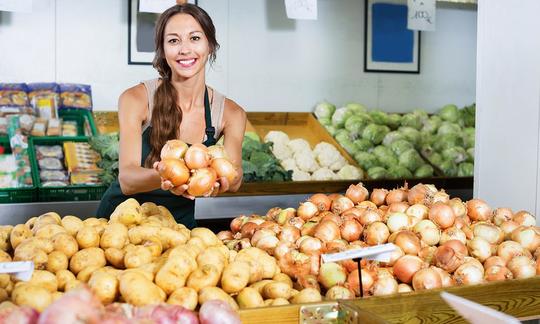

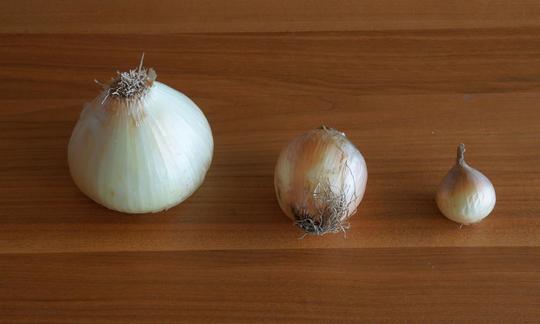

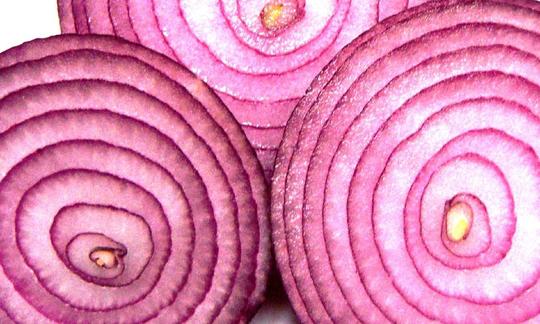

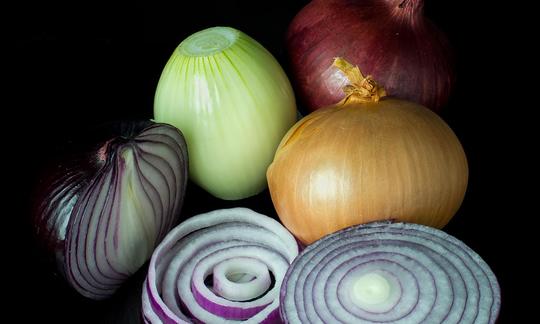

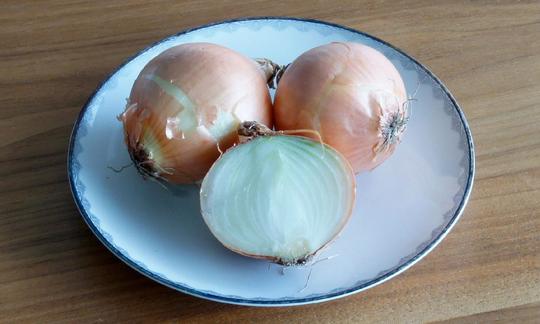

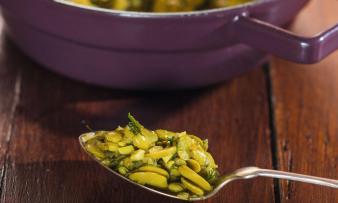
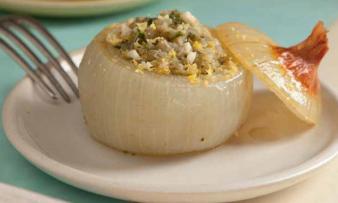
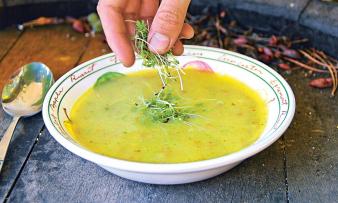





Comments